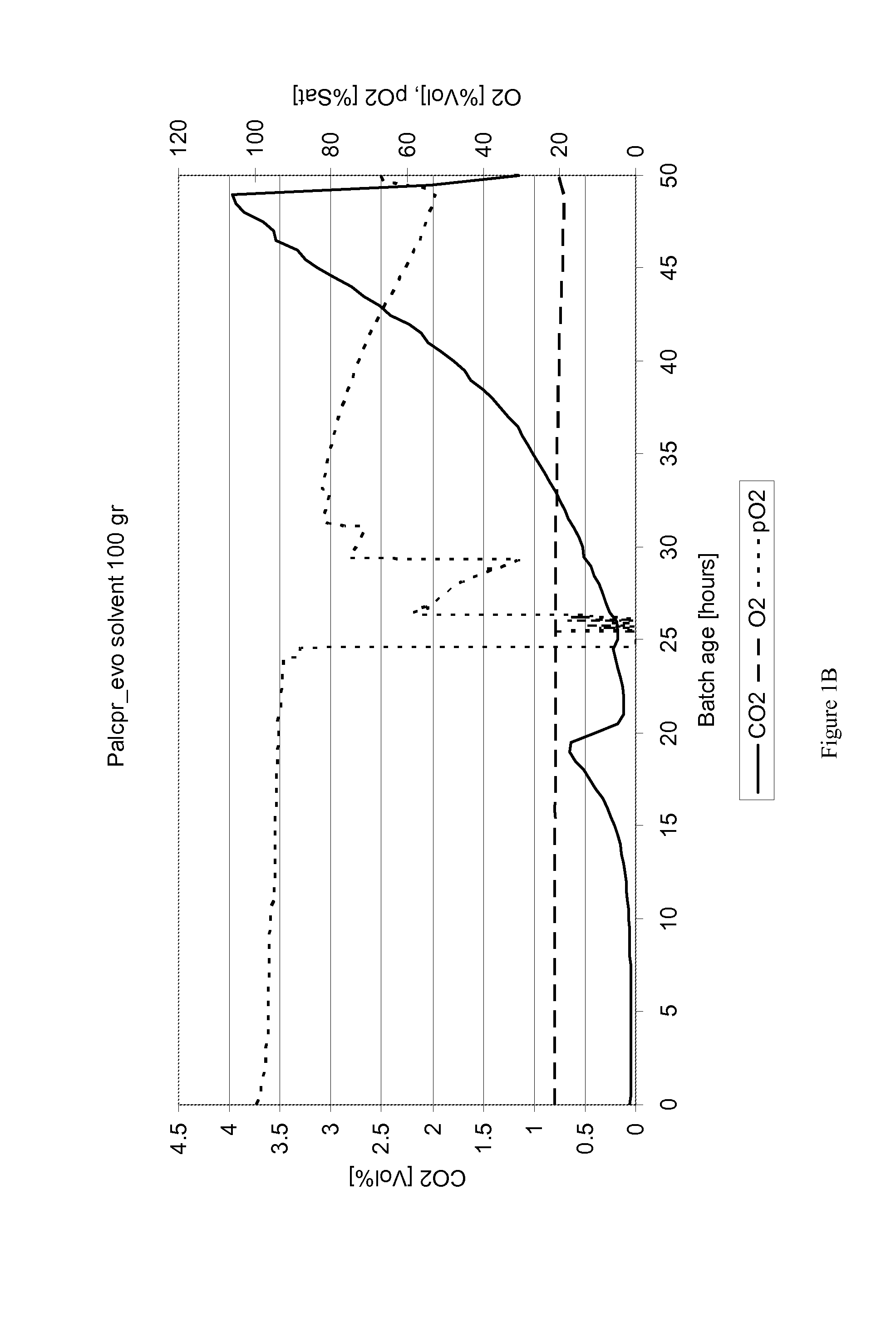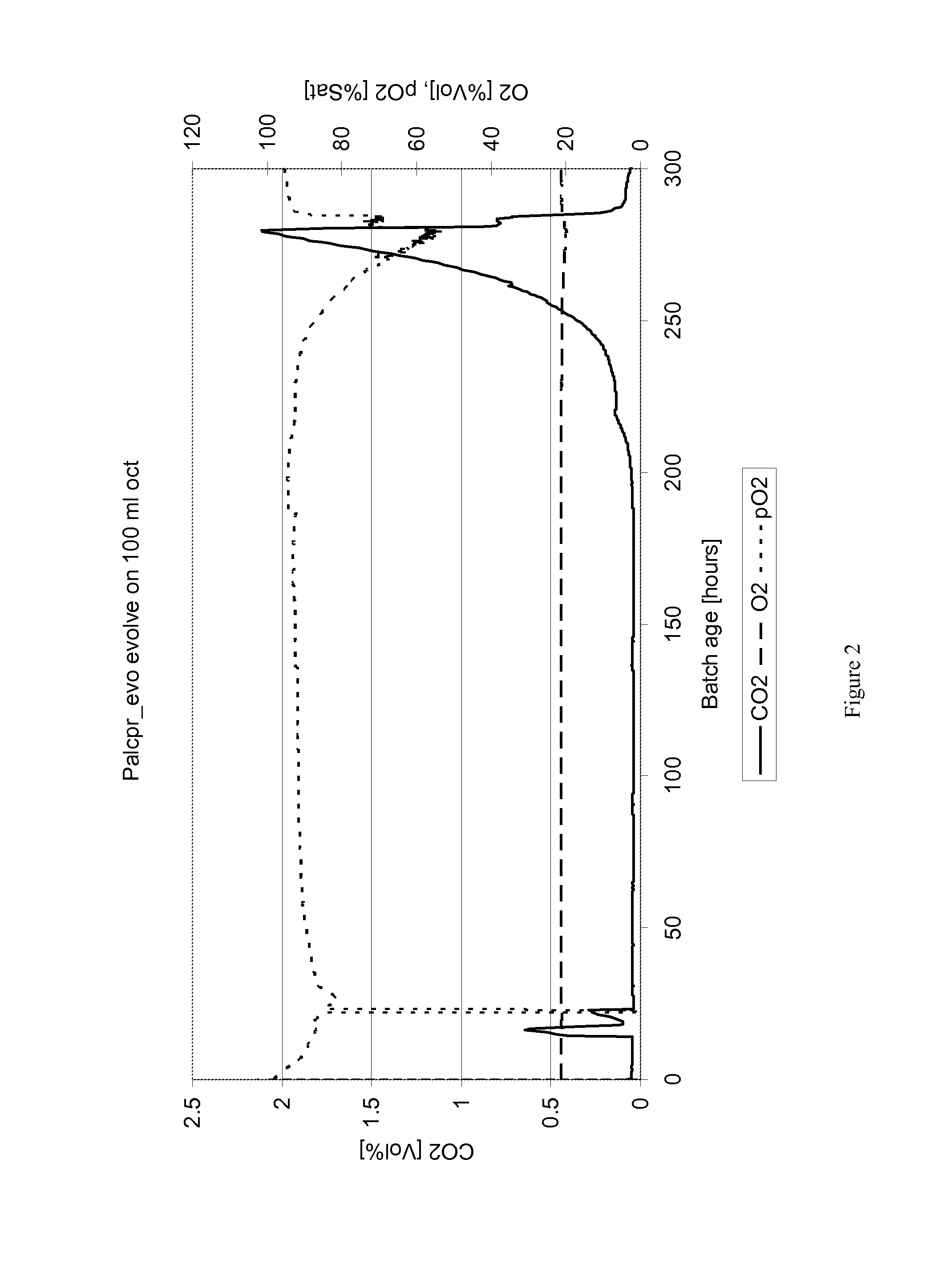Microbial bioreaction process
a bioreactor and process technology, applied in the field of bioreactor process, can solve the problems of product inhibition becoming a problem, the solubility limit of the compound is too low,
- Summary
- Abstract
- Description
- Claims
- Application Information
AI Technical Summary
Benefits of technology
Problems solved by technology
Method used
Image
Examples
example 1
Expression of the PAL-Pathway to Resveratrol in S. cerevisiae Strain Overexpressing Native S. cerevisiae NADP-Cytochrome P450 Reductase (CPR)
[0080]A yeast strain FSSC-PAL2C4H4CL2VST1-pADH1CPR1 was used. This is a strain of S. cerevisiae having introduced therein genes expressing PAL2 from A. thaliana, C4H from A. thaliana, 4CL2 from A. thaliana, and VST1 from Vitis vinifera with overexpressed CPR from A. thaliana (see WO2006 / 089898 and WO2008 / 009728 for details). In summary construction of the strain is described further below and is divided in parts A, B, C, D and E.
A: Construction of a strain overexpressing native S. cerevisiae NADP-cytochrome P450 reductase (CPR).
[0081]The native promoter of S. cerevisiae NADP-cytochrome P450 reductase CPR1 gene (encoded by YHR042W) was replaced with the constitutive S. cerevisiae alcohol dehydrogenase ADH1 promoter via chromosomal promoter exchange using the “bi-partite” PCR-based allele replacement method. Primers A and B were used to generate ...
example 2
Adaptation of Strain PALCPR to the Presence of Solvents
[0090]Yeast strain FSSC-PAL2C4H4CL2VST1-pADH1CPR1 as described in the previous example was subjected to a train of batch fermentations in a fermentor from Applikon containing defined medium according to Verduyn et al. (1992), containing: 10.0 g / L (NH4)2SO4; 3.0 g / L KH2PO4; 0.5 g / L MgSO4.7H2O; trace metals and vitamins with the aim of adapting it to the presence of solvents. The working volume was 1 L and the gas flowrate was set at 1.5 l / m, temperature was uncontrolled and pH was set at 5.5. The first fermentation contained 10 g / l glucose and 50 g / l galactose, and stirring rate was kept low to prevent mixing of the medium- and solvent phase, as illustrated in FIG. 5A in which is seen a fermentor vessel 10 containing the two separated phases 12 (aqueous) and 14 (solvent) agitated by a stirrer 16 at below 200 rpm. After consumption of the glucose and at the onset of galactose consumption, a mixture of 10 ml octylacetate and 40 ml ...
example 3
Determination of Intracellular and Extracellular Levels of Stilbenoids in a Batch Culture of Strain PALCPR
[0091]The last harvested strain as described in previous example was grown in two independent batch cultures with a working volume of 1 liter, containing defined medium according to Verduyn et al. (1992), containing: 10.0 g / L (NH4)2SO4; 3.0 g / L KH2PO4; 0.5 g / L MgSO4.7H2O; trace metals and vitamins and 10 g / l glucose and 100 g / l galactose as the carbon sources. Antifoam (300 μl / L, Sigma A-8436) was added to avoid foaming. The carbon source was autoclaved separately from the mineral medium and afterwards added to the fermentor. In addition, the vitamin and trace metal solutions were added to the fermentor by sterile filtration following autoclaving and cooling of the medium. The fermentor system was from Sartorius BBI systems and consisted of a baffled 3-liter reactor vessel with 1 liter working volume equipped with Biostat B Plus controller. The reactor vessel was equipped with o...
PUM
| Property | Measurement | Unit |
|---|---|---|
| diameter | aaaaa | aaaaa |
| partition coefficient logP | aaaaa | aaaaa |
| partition coefficient logP | aaaaa | aaaaa |
Abstract
Description
Claims
Application Information
 Login to View More
Login to View More - R&D
- Intellectual Property
- Life Sciences
- Materials
- Tech Scout
- Unparalleled Data Quality
- Higher Quality Content
- 60% Fewer Hallucinations
Browse by: Latest US Patents, China's latest patents, Technical Efficacy Thesaurus, Application Domain, Technology Topic, Popular Technical Reports.
© 2025 PatSnap. All rights reserved.Legal|Privacy policy|Modern Slavery Act Transparency Statement|Sitemap|About US| Contact US: help@patsnap.com



